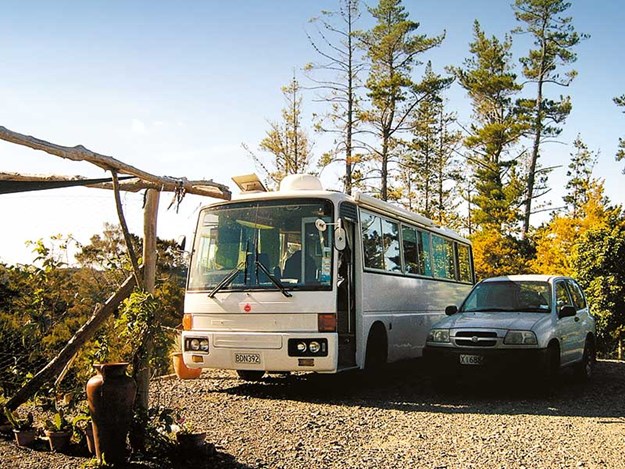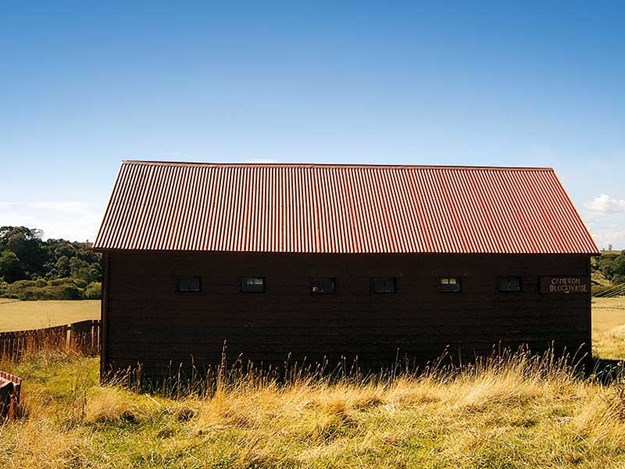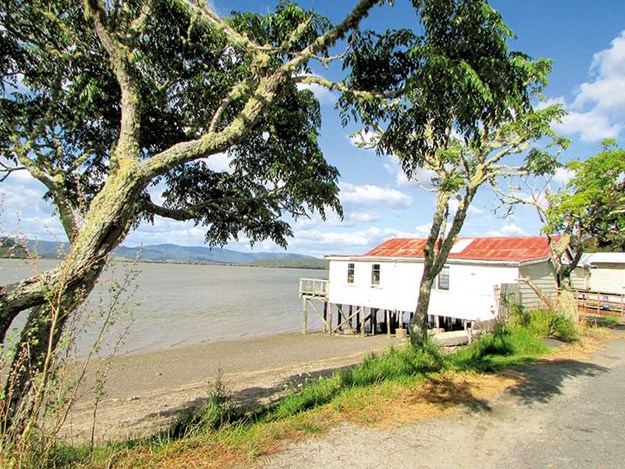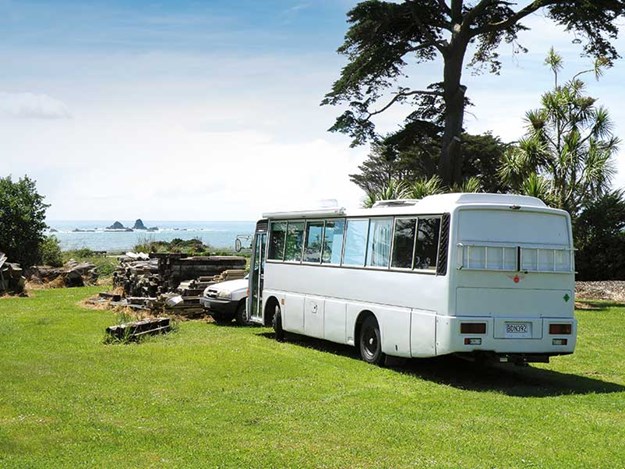The New Zealand Motor Caravan Association (NZMCA) member travel directory lists just about everywhere in the country that motorhomes can park overnight. As well as NZMCA parks, Department of Conservation campgrounds, clubs and holiday parks, there are more than 300 POPs that provide safe, free parking on the private property of other club members. Some POPs charge a small fee for power or water, if needed.
Similar to POPs are ‘charges apply parking’ (CAP) properties. These are parking spots where small charges or a koha may be asked for, as they provide facilities. Sometimes CAPs are pubs and they generally don’t charge visitors who buy drinks or a meal when they are parked overnight. There are nearly 400 CAP properties listed in the NZMCA travel directory and, together with POPs, provide a variety of interesting places to stay.
HISTORIC RUSSELL

We took the vehicle ferry from Opua in the Bay of Islands: destination Okiato, and on to Russell. Turning up a narrow driveway off the road to Russell, we made our way through the bush to a parking area near our host’s home.
Our host in Russell was just leaving for a few days as we arrived, so we had the run of the garden area beside our bus. There was a picnic table and chairs under a shade sail, and from here, we could look down to the waters of Te Wahapu Inlet as we enjoyed a glass of wine in the evening. The following day, we walked along the headland and down to Toretore Island Scenic Reserve where we had a swim and looked up at the white dot on the hillside—our bus. The view was equally spectacular in both directions.
The waterfront settlement of Russell was picturesque and full of reminders of its historic past. Pretty Christ Church, built in 1835 and New Zealand’s oldest surviving church, stood behind the main street. As well as musket ball holes in the weatherboards, a reminder of the Battle of Kororareka in 1845—when Hone Heke famously chopped down the town’s flagpole—the church has the graves of many early settlers, whalers, and the Ngapuhi chief, Tamati Waka Nene.
CAMERON BLOCKHOUSE

Just outside Whanganui, we stayed at another place with historical connections. The parking area took some manoeuvring to get to. It was a tight squeeze for the bus between fences and through gates. However, once parked, we were able to stroll up to investigate a blockhouse on the property.
The Cameron Blockhouse was built by John Cameron in 1868, during the New Zealand Wars, and is a rare example of a privately constructed redoubt. We found the restored blockhouse intriguing. Inside the building were photographs and information about the Cameron family, who planned to flee here for safety, should the need have arisen. The women and children would have climbed into a loft and pulled up the ladder behind them, while the men aimed their muskets through loopholes in the walls. These walls were double thicknesses of totara, packed with clay to make them bulletproof and fireproof. Luckily, this refuge was never needed.
POPs WITH BEACHFRONT VIEWS

One of our favourite POPs was just a couple of kilometres north of Collingwood, in Golden Bay. This large property was beside a remote stretch of beach, and while we were parked there for a few days, we didn’t see a soul, except a guy in a ute who drove past one day and waved. The deserted beach stretched in both directions. We wandered south as far as the Rautaniwha Inlet and looked across at the little township of Collingwood. It was a peaceful spot and a good base for exploring Farewell Spit.
On the other side of the South Island, we enjoyed views of a very different coastline: Cape Foulwind. We parked beside the Star Tavern, a friendly POP pub. After having lunch there, we took the car to the end of the road, where the Cape Foulwind Walkway began. This two-and-a-half hour (return) walk passed a lighthouse and a fur seal colony, with wonderful views from the cliff-tops.
CHARMING CREEK WALKWAY

Not far from Westport was Seddonville, with another hotel to park behind. The little coal-mining settlement was named after a visit from the premier, Richard Seddon, in 1903. The publican recommended the nearby Charming Creek Walkway. We took up his suggestion to cycle it. It was an interesting trip, though the number of remaining sleepers on the old rail tracks made it rather a bumpy experience.
The walkway followed the route of a historic tramway. We cycled through native bush, over swing bridges and through old railway tunnels. Rusting relics of coal-mining and sawmilling days could be seen beside the track, encouraging us to investigate. The stunning Mangatini Falls was a perfect place to have lunch before we cycled back to our bus.
POPs ON CYCLE TRAILS
We’ve parked beside hotels in various corners of New Zealand while riding some of the country’s wonderful cycle trails. Northland’s Horeke Tavern was the perfect POP for us to visit while cycling the final section of the Twin Coast Cycle Trail. The Hokianga Harbour lapped close to our wheels as we watched the sun turn the sky shades of red at sunset. After completing the trail by cycling across the mangrove estuary boardwalk and into Horeke, we rewarded ourselves with a cold drink in the tavern garden. Later we checked out the Mangungu Mission House further along the road. Overlooking the Hokianga, this historic building was the place where local chiefs signed the treaty of Waitangi in 1840.
Hayes Engineering Works at Oturehua was an attraction in its own right. We stayed there when cycling the Otago Rail Trail and spent an afternoon admiring the many innovative conveniences the Hayes family incorporated into their homestead, built just after the First World War. It had its own electricity supply, music piped into each room, and a bathroom, complete with a shower. The rooms were set out as they would have been in that era, and one could imagine the family had just popped out and would be back later.
Our favourite pub POP, the Honest Lawyer on the Monaco Peninsula, Nelson, had its own take on history—the building was designed to look like an old English Inn and its rooms were decorated with ancient bric-a-brac. We cycled past while on the Tasman Great Taste Trail and couldn’t resist pulling in for a cold cider.
Later, we moved our bus into the motorhome parking area in the pub’s grounds and enjoyed a great meal or two in the Honest Lawyer restaurant. The Monaco Peninsula was worth a stroll around; there were pretty views of the Waimea Inlet.
A SECRET GARDEN
We spent a week parked at the Lignite Pit Cafe and Secret Garden near Dunedin. Having been away from home for several months, we had mail that needed attention. The owners of the Lignite Pit were happy for us to have our mail forwarded there so we took the opportunity to base ourselves in the secret garden while we waited. It was handy for visits to Invercargill and Bluff.
The disused, open-cast, lignite mine had been transformed into a lake, complete with attractive gardens. We enjoyed strolling along the network of paths around the lake, feeding the hungry ducks and swans. It was just one of the many POPs we have enjoyed visiting on our travels and we’re looking forward to discovering many more.
Further information on PoP in NZ
- Where possible, ring ahead to book the POP. Read the instructions and restrictions given in the travel directory.
- POP and CAP property owners can provide a wealth of local knowledge, often recommending good restaurants and interesting places to visit.





